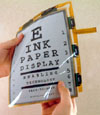Stepping out of the frame

According to Parks Associates, 12 million LCD picture frames will be sold in 2010, up from 700,000 in 2005. They attribute this explosive (projected) growth to falling hardware costs and people's increased comfort with digital imaging technology.
For some years now, Accenture Technology Labs has maintained a Home Lab in which (among other things) we've experimented with large numbers of LCD picture frames showing successions of digital images and video. (The Lab was built in the days before real LCD picture frames, so we literally had to take flat-panel monitors out to a frame shop. We got some looks.) Certain people (me) expected the setup to be irritating--instead, it's quite peaceful. Over the course of 10 minutes or so, Lab visitors go from surprise to uncertainty to asking how they can get the technology for their living rooms.
The Home Lab experience convinced us that there'd be a huge market for electric picture frames, which would in turn address the major objection to high-volume digital photography (it's usually raised by a spouse) which goes like this: "What are we going to do with 10,000 family pictures?! Print them?! When will we ever have time to look at them all?!"
With those astute questions in mind, what's the upper limit on pixels per home? Pretty high. LCD frames are getting bigger, of course, but there's another possibility that bypasses them entirely: We're getting closer to large, flexible, paper-thin displays--electric wallpaper. If you can fit 100 photographs on your walls simultaneously, and they stay up for 10 minutes at a time, you can get through 10,000 pictures in 1,000 minutes or roughly 17 hours. With this arrangement, even a large collection of photographs starts to seem pretty paltry. Glue the wallpaper to doors, ceilings, floors, countertops and so on and the volume challenge--feeding the pixel beast--becomes even more acute.
I have no doubt, however, that the world's amateur photographers are up to the challenge. It raises another concern, however: Perhaps the Home Lab people should start exploring the addictive, will-sapping dangers of being wrapped in a warm, 360-degree cocoon of permanent visual nostalgia.
